Chasing the spawn
FLW Tour pros offer up tips and techniques for capitalizing on the spawn as it migrates north during changing seasons
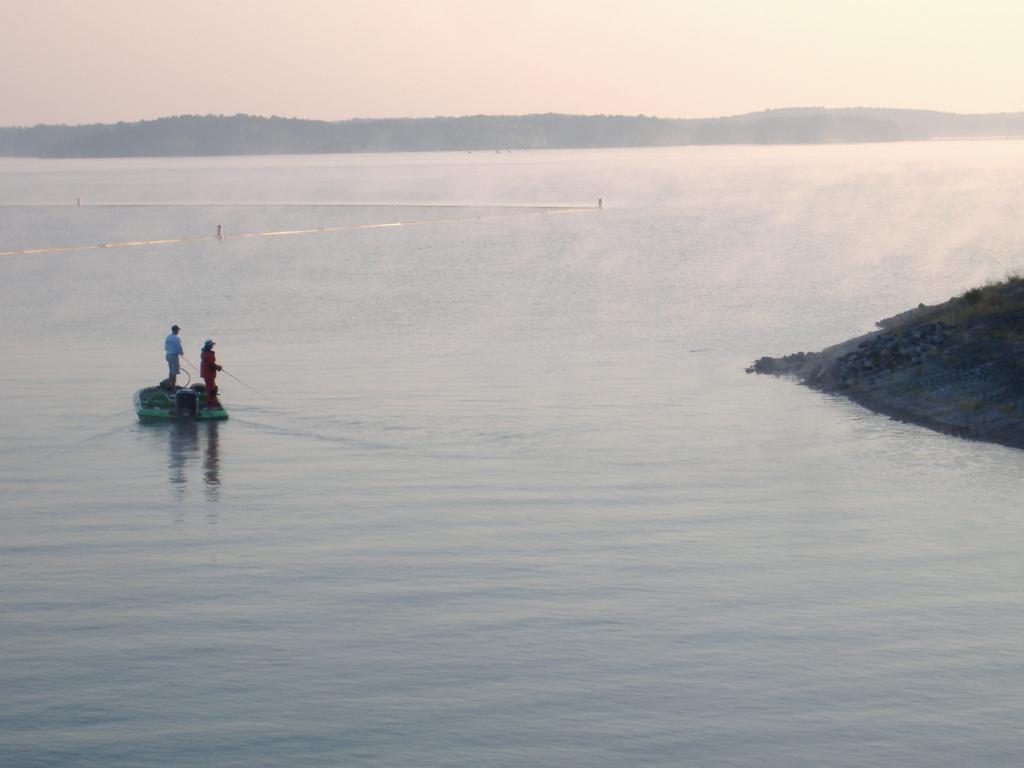
Round up a half-dozen bass pros anywhere in the nation, ask them to name their favorite season, and odds are good they’ll say, “the spawn,” the time of year when bass are most aggressive.
The spawn is an ongoing event as it occurs across the nation, beginning as early as October in Florida and running as late as September in Michigan.
September?
Yes, said bass pro Kevin Vida of Clare, Mich.
Last year during a benefit tournament, we caught three smallmouths on beds at the end of September on a small lake in the Traverse City area,” said Vida, a seven-time winner on FLW Outdoors’ bass-fishing circuits.
Were those fish dropping eggs or just hanging out on the beds? Vida wasn’t sure, but his discovery points to an essential truth of bass fishing: Find a bed and a bass probably isn’t far away.
“My favorite time of year is prespawn into the spawn, when the fish are fat and aggressive,” said Clark Wendlandt of Leander, Texas, who’s won three Walmart FLW Tour events by catching spawning bass in March and April. “A lot of the fish are shallow, and that’s what people like.”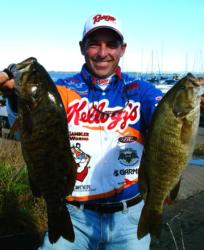
Bass in lakes and rivers don’t all spawn at the same time, but as a general rule, smallmouths get the urge when the water reaches 55 degrees, while largemouths come on when the temperature hits the low 60s. Vida, again, has seen an exception to the rule.
“I’ve seen largemouths spawn in 45-degree water,” he said. “Around here (in the Northern climes), if it doesn’t get warm until the end of June, they’re still going to dump their eggs. Four straight days of stable weather is the key.”
Finding a bed is crucial to finding spawning bass
Depending on water clarity, smallmouths make nests in depths ranging from 18 inches to 20 feet, while largemouths nest in depths as shallow as 6 inches and as deep as 15 feet, though most are in the 1- to 4-foot range. Males make the beds, while the females hang out in deeper water until they are ready to lay their eggs.
Most pros agree that moon phases play a role in the timing of the spawn, with full moons and new moons being best.
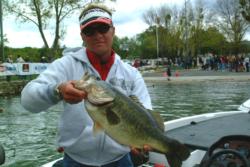
“More fish move up during those periods than in between,” said Forrest Wood Cup winner Luke Clausen of Mount Juliet, Tenn.
“If it’s May in Michigan and a full moon’s coming on, then two days prior I’m looking shallow,” Vida said.
Stren Series Championship and FLW Tour winner Brent Ehrler of Redlands, Calif., points to another important influence on the spawn.
“More daylight is the key,” Ehrler said. “I’ve heard it said that a new moon brings in new fish, but I’ve never been on one lake long enough to know if that’s true or not. When I get to a lake, they’re either spawning or they’re not.”
Bass feed little during the spawn, but defend their nests aggressively and strike lures dropped over their beds. Even so, a bedded bass isn’t necessarily a bass in the bag. Common are the tales of fishermen who spend an hour trying to coax a hog into hitting only to come up empty. Obviously, ol’ bucketmouth can be pretty fickle during the spawn.
Where to look
Be they largemouth, smallmouth or spotted, bass prefer to spawn on hard bottom. Mud doesn’t cut it this time of year, though smallmouths sometimes spawn on a bottom that’s less than perfect. So finding hard-bottomed shoreline is the first principle when going forth during the spawn. Obvious signposts such as overhanging trees, submerged boulders and fallen logs are always worth a look, but how about that log standing upright in the water? Vida has found bass beds next to the big timber poles that marinas use to build docks.
If you find a small area of hard bottom surrounded by a larger area of soft bottom, you’ve hit pay dirt and it’s time to go to work. Clausen said submerged road beds are great places to fish during the spawn.
“Find a road bed on a flat, and somewhere on that road there will be spawning smallmouths,” Clausen said. “Don’t rule anything out. I’ve found fish spawning on the cross members of docks and the trim tabs on flats boats. They actually lay their eggs on the tabs if they’re under water.”
When scouting for beds, Ehrler looks for the bright, white shells of mussels, which indicate a hard bottom. Mussel shells often are found in the middle of the beds and stand out against the paler bottom.
“Another thing to look for,” Ehrler said, “is that one lonely stick lying on the bottom. It might be only 2 feet long and as big around as your thumb, but they’ll spawn right on that stick. Everywhere I’ve fished I’ve seen that.”
Vida has fished from Beaver Lake to Lake St. Clair and said the spawn is the same everywhere with the exception of Lake Okeechobee, where bass “build nests in cover that’s so heavy you wonder how the sunlight ever gets through.”
Techniques for landing the mother lode
Fishing bedded bass is most often done by sight, so a good pair of polarized sunglasses is essential gear this time of year. When you find a bed, keep your distance.
“Try to stay as far away as you can and still catch them,” says Koby Kreiger of Okeechobee, Fla., a four-time Stren Series winner, including the championship. “They’re very spooky because the water is shallow and they’re getting pressured. It’s hard to say an exact distance because every fish is different, but I’d keep a minimum of 20 feet from a bed. Don’t run a trolling motor any closer than that, either anchor or Power-Pole. Position your boat so it doesn’t move.”
Kreiger says there’s a “hot spot” on every bass bed: “You’ll pitch it in there three or four times and get no reaction. But then you hit that spot, and the fish hits it.”
Clausen says, “Most of the time you can tell within the first five minutes how they’re going to react.”
Most pros use some type of plastic lure during the spawn. Popular choices include tube baits, floating worms, Zoom’s 8-inch lizard and the Super Hog, Senko-style baits, as well as Berkley’s Jerk Shad, Power Hog, Mud Critter, Slim Shaky Worm, Chigger Craw and Gulp minnow. Other choices include the various topwater and jerkbaits plus that old standby, the jig-and-pig.
Not surprisingly, the pros offer a wide variety of techniques for targeting bedding bass.
Koby Kreiger: “It doesn’t matter where I’m at, I always go with the Zoom 8-inch Blueberry Lizard or the white Zoom 4-inch Super Hog. On Lake Champlain, it’s a green-pumpkin tube or something else that looks like a crawfish.”
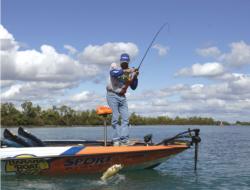 Clark Wendlandt: “The Gambler Ace is my best bait, and I also like their floating worm. Senko-style baits are a good choice, and if I’m strictly sight-fishing, I’ll go with a tube bait. If I can’t see them, I’ll use a topwater or jerkbait.”
Clark Wendlandt: “The Gambler Ace is my best bait, and I also like their floating worm. Senko-style baits are a good choice, and if I’m strictly sight-fishing, I’ll go with a tube bait. If I can’t see them, I’ll use a topwater or jerkbait.”
Kevin Vida: “For smallmouths, it’s the Berkley Jerk Shad or the Mizmo 4-inch green-pumpkin tube. For largemouths, I’ll start with a Berkley Gripper jig-and-pig. I might use a creature-style bait if they’re not hitting that.”
Luke Clausen: “Drop-shots on a short 2- to 4-inch leader with a wacky-rigged Berkley Slim Shaky worm are really effective for smallmouths on beds. It stays at eye level and is easy for them to hit. It’s either that or a 3-inch Gulp minnow or leech. If they’re tougher, I’ll try a Berkley Power Hog on a Texas rig.”
Brent Ehrler: “I like heavy-line Texas rigging. I’ll rig a worm with a ¼-ounce tungsten sinker on 20-pound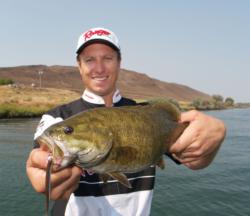 fluorocarbon line because I don’t want a big one to break off. Berkley’s 3-inch Chigger Craw or Mud Critters are both fairly small baits that work good on beds. Green is best. I don’t like bright colors. Some people like bright baits, because when they disappear, they set the hook. But if the fish is between you and the bait, you’ll snag it in the side and have to release it. I’ve had that happen.”
fluorocarbon line because I don’t want a big one to break off. Berkley’s 3-inch Chigger Craw or Mud Critters are both fairly small baits that work good on beds. Green is best. I don’t like bright colors. Some people like bright baits, because when they disappear, they set the hook. But if the fish is between you and the bait, you’ll snag it in the side and have to release it. I’ve had that happen.”
While fishing for bedding bass can reap some huge rewards, Vida says that anglers might want to take into consideration other ecological factors when planning for a day on the water during the spawn.
“I love fishing for spawning fish, but I don’t advocate it,” he said. “When you catch a fish off a bed, release it instantly. It’s critical to practice catch-and-release this time of year.”